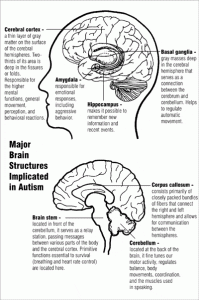 A biochemist at Rice University claims that there may be a link between autism and Type 2 diabetes since the two disorders share common biochemical and genetic markers.
A biochemist at Rice University claims that there may be a link between autism and Type 2 diabetes since the two disorders share common biochemical and genetic markers.
“It appears that both Type 2 diabetes and autism have a common underlying mechanism — impaired glucose tolerance and hyperinsulinemia,” wrote Dr. Michael Stern in an opinion paper published in a recent issue of the journal “Frontiers in Cellular Endocrinology.”
Hyperinsulinemia is a condition in which insulin levels in the bloodstream remain elevated. Both obesity and Type 2 diabetes are associated with insulin resistance, and hyperinsulinemia often precedes insulin resistance.
“It will be very easy for clinicians to test my hypothesis,” said Stern, who teaches cell biology and biochemistry at Rice University. “They could do this by putting autistic children on low-carbohydrate diets that minimize insulin secretion and see if their symptoms improve.”
Dr. Stern also noted that, if hyperinsulinemia is positively associated with autism, it would warrant more thorough testing of glucose tolerance in pregnant women.
According to Stern, he first hypothesized that autism and Type 2 diabetes could be linked by common factors several years ago, but assumed that someone else had already established the link.
Stern conducts his research at his lab, located at Rice University’s BioScience Research Collective, where he focuses on investigating genetic links between genetic disorders such as neurofibromatosis—which significantly increases risk of autism and autism spectrum disorders, such as Asperger’s syndrome.
According to the U.S. Centers for Disease Control and Prevention, autism spectrum disorders affect about nine out of every 1,000 children in the U.S. Autism and its related disorders are largely based in genetics, but scientists still do not clearly understand their genetic associations.
The biochemical pathway called PI3K/Tor is known to be linked with autism, since at least four genes associated with increased risk of autism produce proteins that play key roles in the pathway. Stern had previously been studying an abnormality in the synapses of fruit flies that appeared similar to abnormalities in mice and rats who demonstrated defects associated with the mGluR-mediated long-term depression pathway.
“I had also spent a lot of time thinking about insulin signaling because another project in my lab is an endocrinology project in which we’re studying how key proteins involved in insulin signaling affect the timing of metamorphosis in fruit flies,” said Stern.
Stern’s work allowed him to see the relationship between diabetes and autism: he knew that the PI3K/Tor pathway was responsible for intracellular insulin signals and he knew that insulin could affect synapses the same way that defects in the mGluR pathway could affect them. However, he didn’t immediately test or publish his hypothesis.
“When I read that the incidence of autism was increasing, and combined that with the fact that the incidence of Type 2 diabetes is also increasing, it seemed reasonable that each increase could have the same ultimate cause — the increase in hyperinsulinemia in the general population,” he said. “I didn’t do anything with this notion for a few years because it seemed so obvious that I figured everyone already knew this hypothesis, or had tested it and found it was not true.”
Stern believes that the possible effects of insulin on neural disorders warrants more study.
“Based on what’s already in the literature, insulin needs to be taken seriously as a causative element in autism,” he said. “I hope that clinicians will take the next step and put this to a rigorous test and determine how to best use this information to benefit patients.”